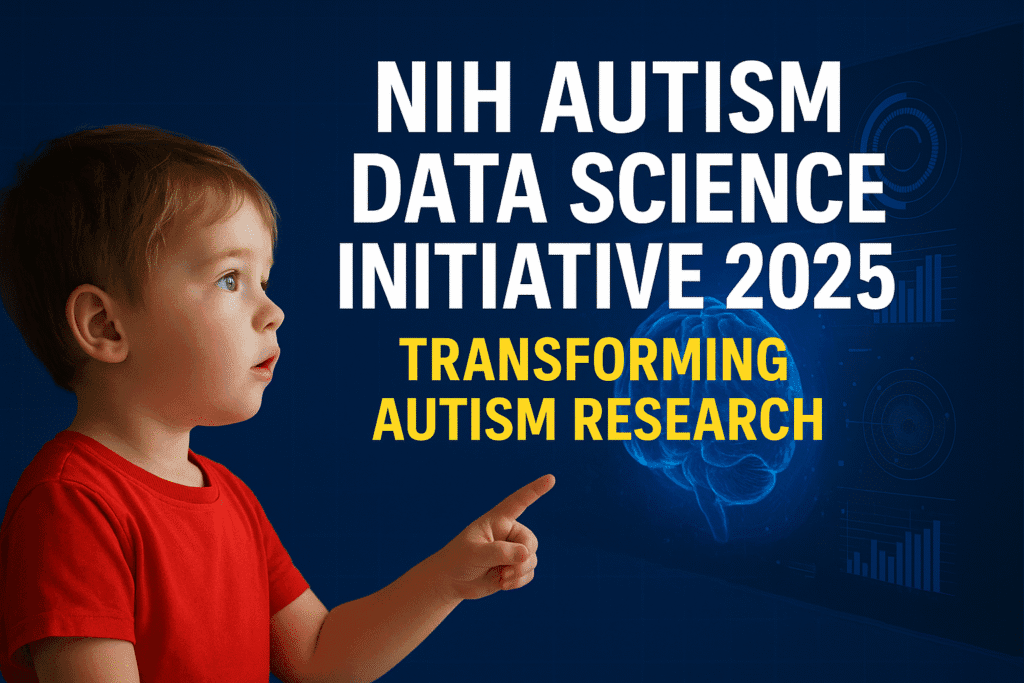Introduction: Why the NIH Autism Data Science Initiative 2025 Matters
Autism research has always been about piecing together a puzzle — a puzzle made of genetics, environment, behavior, and neuroscience. In 2025, the NIH Autism Data Science Initiative 2025 has emerged as a transformative project that seeks to harness the power of big data and artificial intelligence to revolutionize how we understand autism spectrum disorder (ASD).
For families, educators, and medical professionals, this initiative is more than just research. It’s about faster diagnoses, personalized interventions, and improved quality of life for millions of autistic children and adults across the globe.
In this detailed article, we’ll explore the mission, strategies, tools, and potential impact of the NIH Autism Data Science Initiative 2025.
🧠 What Is the NIH Autism Data Science Initiative 2025?
The NIH Autism Data Science Initiative 2025 is a program led by the U.S. National Institutes of Health (NIH). Its core mission is to integrate massive data sets — from genetics, brain imaging, behavioral studies, and clinical trials — into a centralized, AI-powered platform.
Key goals include:
- 📊 Centralizing autism research data into one accessible hub.
- 🤖 Using artificial intelligence and machine learning to uncover hidden patterns.
- 🧬 Linking genetics with behaviors and outcomes to create personalized interventions.
- 🌍 Global collaboration, allowing scientists worldwide to contribute and analyze data.
This initiative is considered one of the most ambitious autism-related projects of the decade.
📊 The Role of Big Data in Autism Research
Traditionally, autism studies were limited by small sample sizes and inconsistent methods across institutions. The NIH Autism Data Science Initiative 2025 changes that by pooling data from:
- Clinical trials
- Hospital records
- Educational assessments
- Brain scans (fMRI, EEG)
- Genetic sequencing studies
With tens of thousands of participants, researchers can now find statistically powerful insights. For example, instead of studying 100 children in one trial, the initiative allows comparisons of 100,000+ children worldwide.
🤖 Artificial Intelligence Meets Autism Science
The NIH Autism Data Science Initiative 2025 is heavily invested in AI and machine learning. These tools help:
- 🔍 Detect early autism markers in speech, eye movement, or play behavior.
- 🧩 Classify autism subtypes for more personalized treatment plans.
- 💡 Predict treatment outcomes, saving time and resources for families.
- 📱 Develop AI-based apps to assist with communication and therapy.
Imagine an AI algorithm analyzing videos of toddlers’ eye movements and detecting autism risk years earlier than traditional diagnosis. This is no longer science fiction — it’s one of the program’s key research goals.
🧬 Genetics, Environment, and the Autism Puzzle
One of the most fascinating aspects of the NIH Autism Data Science Initiative 2025 is its integration of genetic data. Scientists are investigating:
- How rare genetic mutations influence autism risk.
- Why autism appears more often in boys than girls.
- How environmental factors (e.g., prenatal exposure, pollutants) interact with genes.
By analyzing millions of genetic data points, the initiative aims to map out the autism genome landscape, helping families understand the biological side of autism.
🏥 Real-World Impact: How Families Benefit
The big question: what does the NIH Autism Data Science Initiative 2025 mean for parents, caregivers, and autistic individuals?
- Earlier Diagnosis
AI-driven screenings could allow doctors to detect autism before age 2. - Personalized Therapy
Instead of a one-size-fits-all approach, interventions can be tailored to a child’s unique genetic and behavioral profile. - Better Education Planning
Data-driven insights could inform Individualized Education Programs (IEPs) with greater accuracy. - Reduced Healthcare Costs
Early interventions lead to better long-term outcomes, reducing lifetime costs for families and governments.
🌍 Global Collaboration and Data Sharing
Unlike past research, the NIH Autism Data Science Initiative 2025 encourages international cooperation. Data is anonymized and shared across borders, allowing scientists from Asia, Africa, Europe, and the Americas to work together.
This global perspective ensures diversity in research, recognizing that autism can look different across cultures and environments.
🏆 Success Stories So Far
Even though the NIH Autism Data Science Initiative 2025 is relatively new, early outcomes are promising:
- 🧠 AI models are already detecting autism risk with 85% accuracy in infants as young as 12 months.
- 🧬 Genetic breakthroughs have identified over 100 new autism-related gene variants.
- 📱 Mobile tools developed through the initiative are helping nonverbal children communicate.
These successes provide hope and validation that the project is on the right path.
💡 Challenges the Initiative Faces
Of course, such an ambitious program faces obstacles:
- 🔐 Privacy concerns around sensitive genetic and medical data.
- 💰 Funding requirements for long-term sustainability.
- ⚖️ Ethical debates on AI use in health predictions.
- 🌐 Digital divide, as not all families worldwide have equal access to technology.
Yet, the NIH is actively addressing these issues with strict privacy rules, funding partnerships, and transparency in research practices.
🔮 The Future of Autism Research With NIH Autism Data Science Initiative 2025
Looking ahead, experts believe this initiative could lead to:
- 🧬 Personalized autism medicine, just like personalized cancer treatments.
- 🧑🏫 AI tutors to support autistic students in classrooms.
- 📊 Predictive models that forecast autism risk before birth.
- 🌍 Global autism databases accessible to both researchers and families.
The potential is limitless — and the NIH Autism Data Science Initiative 2025 is paving the way.
✨ Final Thoughts
The NIH Autism Data Science Initiative 2025 is more than a government program — it’s a revolution in how we think about autism. By uniting big data, AI, genetics, and global collaboration, this initiative has the power to change millions of lives.
Families deserve hope, and science is finally catching up with that promise.
💙 Autism is not a limitation. It’s a different way of experiencing the world. With science, compassion, and innovation, we can build a brighter future together.

